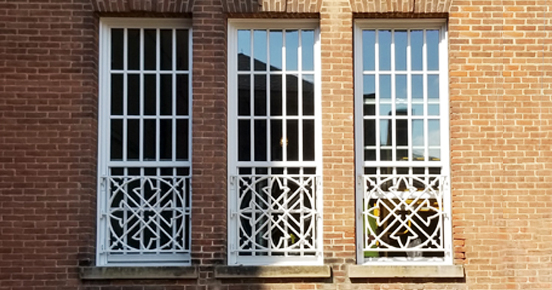New Windows with an Old Twist
November 7, 2019

Ohio University’s “The Ridges” building complex is getting some new windows with a familiar face. Graham is proud to play a role in restoring a part of this historic site’s magnificence.
An Intriguing History
The site opened in 1874 as the Athens Lunatic Asylum, one of numerous psychiatric hospitals built according to the “Kirkbride Plan” in the mid-to-late-19th century. This spreading “bat wing” style floor plan was designed to ensure patients were granted adequate exposure to natural light and air circulation.
 |
| Example of a Kirkbride Plan |
Despite its well-intentioned design, the early years of the asylum reflected the primitive state of mental health treatment at the time. As medical science improved during the 20th century there was a public shift in the perception of asylums as unnecessarily cruel, prison-like institutions.
Archaic practices such as hydrotherapy, shock therapy, and lobotomies came to be seen as inhumane. This led to a decline in the usage of large Kirkbride facilities across the United States, and many of them followed a pattern of abandonment and deterioration.
It also contributed to a spooky aura that “haunts” such Kirkbride locations since.
In the 1980s the property (by then called the Athens Mental Health Center) was the subject of a naming contest to redefine its image, becoming “The Ridges.”
By the early 90s much of the property had fallen into disrepair. Over the years the site became an attraction for paranormal enthusiasts and urban explorers. The hospital continued operations until closing its doors in 1993, at which time it was deeded to Ohio University.
Since coming under the care of the university, The Ridges has seen much better days. The former administration portion of the hospital is now Lin Hall and houses the school’s Kennedy Museum of American Art. It also includes the Voinovich School of Leadership and Public Affairs, an auditorium, and office and storage space. The Ridges is listed on the U.S. National Register of Historic Places.
It’s currently under further restoration and that’s where Graham comes in.
Up in Your Grille
The most difficult and unique part of replicating the old windows was accommodating the historic cast iron grilles that adorn the bottom lites. The university was determined to maintain the aesthetic properly and brought in a historic consultant to assist the effort.
The grilles weighed between 13-15 pounds per square foot, roughly 3 times as heavy as insulated glass, and would need to be carried in part at the panning.
Tim Davis, project manager for AR Design and a Graham Architectural Products rep, described the challenge. “Because the grilles were existing components that had a certain width, we had to design the sizing of the window to respect the grille.” Davis continued, “there wasn’t much clearance between the edge of the grilles and the brick, so we wrestled with that.”
Graham’s designers made custom modifications to the panning system to receive the grilles, including a special strap anchor that attaches to the window jambs.
Said Davis, “We worked with HGC Construction making the support clips and retainer clips to hold the grilles and put them in, and also make them so the university can take them out. So if somebody breaks a lite of glass or they need to do something with the window five years from now, the clips are made so they can raise them and take the grilles out and have access to the outside of the window.”
Graham provided over 300 of its 2200 Series Single Hung and 1200 Series Fixed windows for the project.

To find out more about the Graham window products used on this project, contact Bruce Croak, Graham’s marketing manager.

